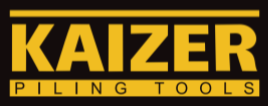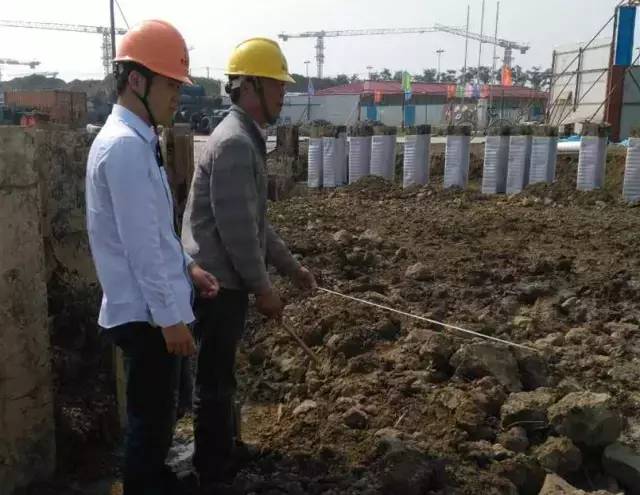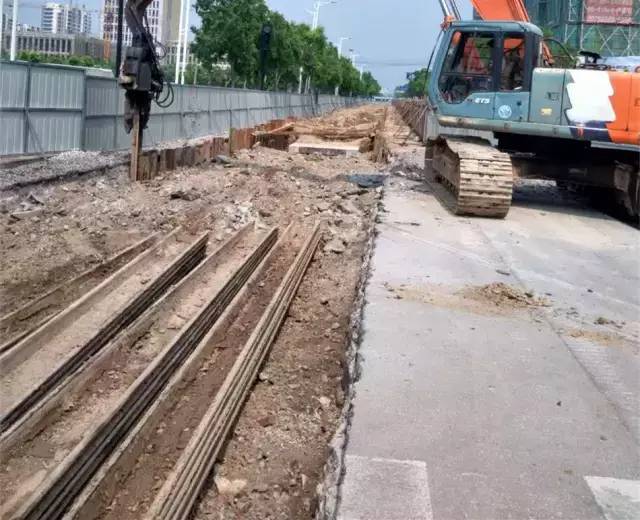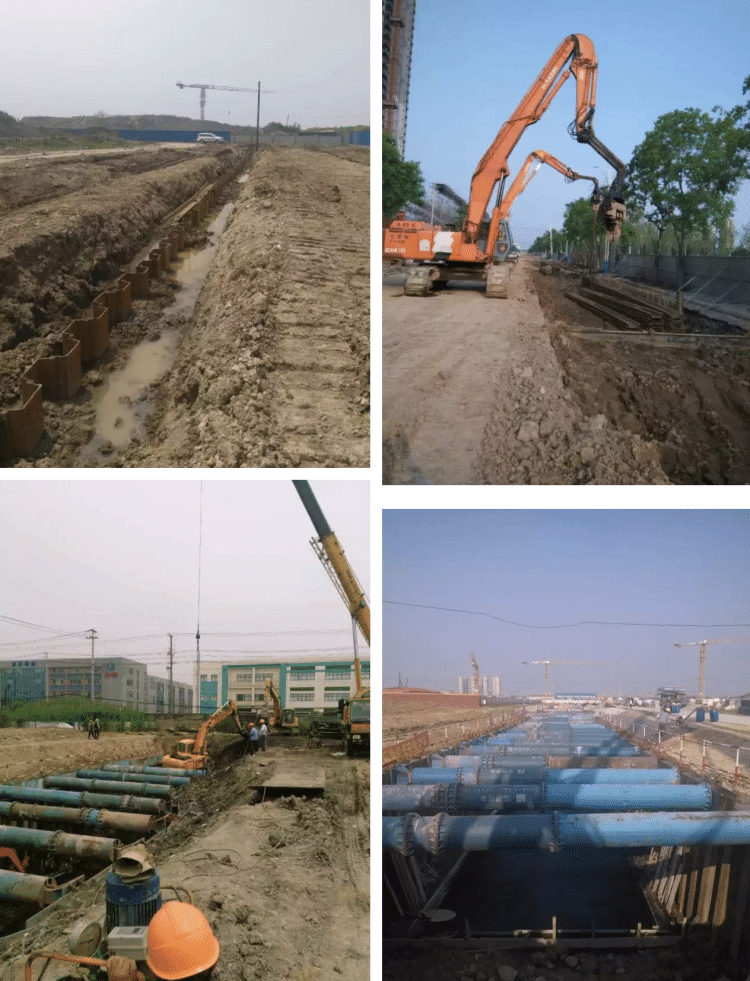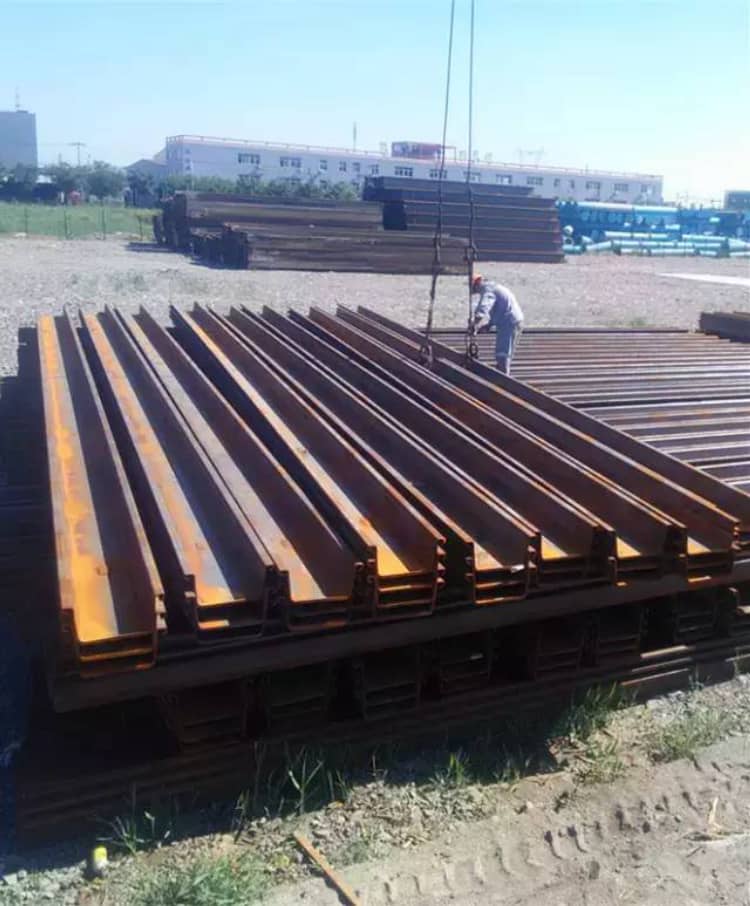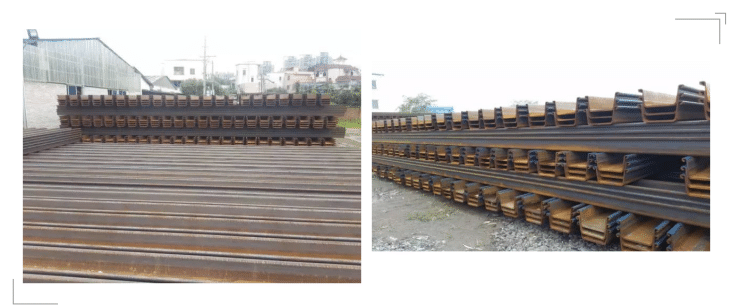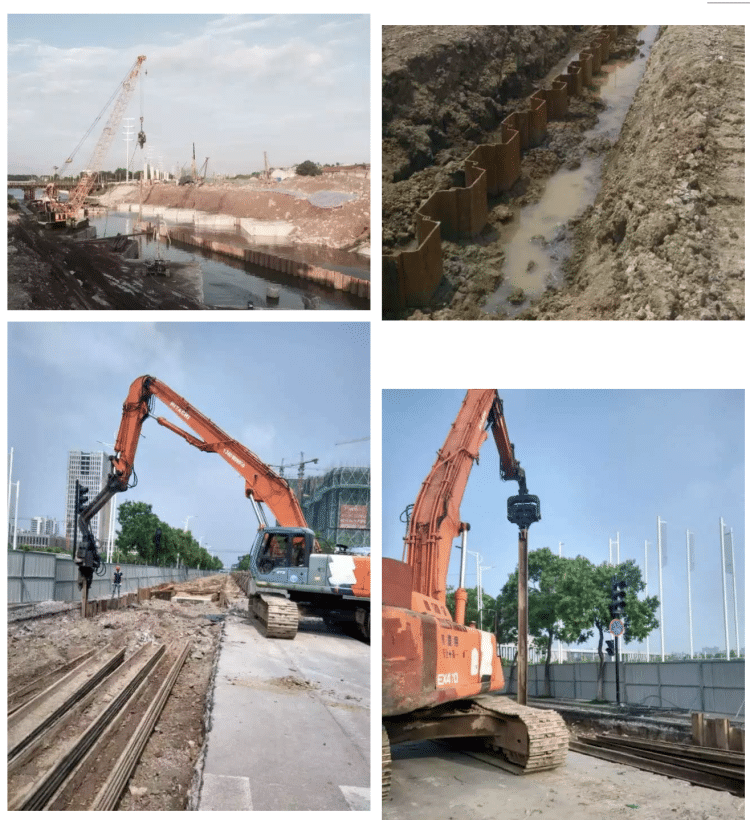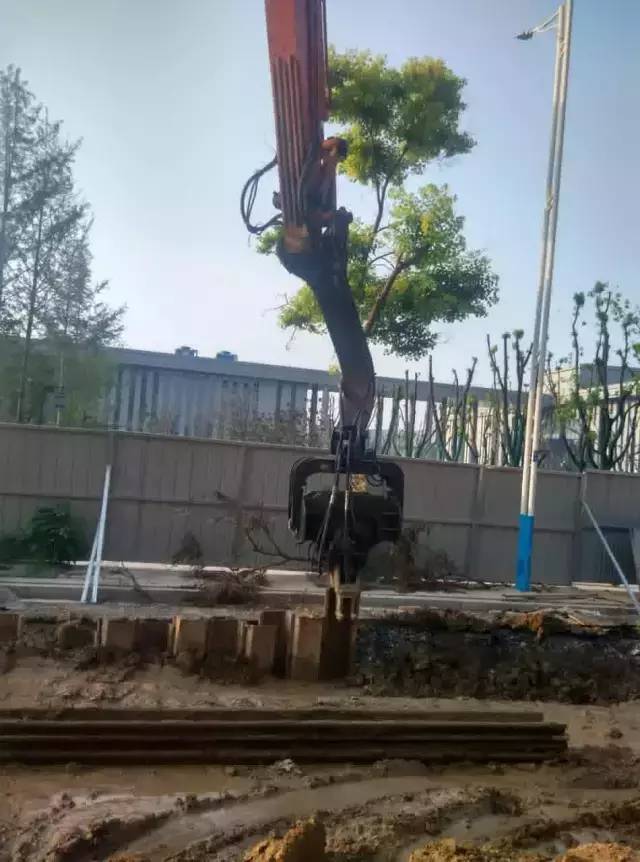1, General requirements
1. The location of the steel sheet piles should meet the design requirements and facilitate the construction of the trench foundation, that is, leave room for formwork and de-molding outside the most prominent edge of the foundation.
2. The support plane layout shape of the foundation trench steel sheet piles should be as straight and neat as possible, avoiding irregular corners, to facilitate the use and support set of standard steel sheet piles. The dimensions of each perimeter should be as large as possible.
3. During the entire foundation construction period, during the construction operations such as excavation, lifting, steel bar tying, and concrete pouring, it is strictly forbidden to collide with the support, arbitrarily remove the support, arbitrarily cut or weld on the support, and heavy objects should not be placed on the support.
2, Support line measurement
Based on the design section width requirements of the foundation pit and trench excavation, the steel sheet pile driving position line is measured and laid out, and the steel sheet pile driving position is marked with white lime.
3, Steel sheet piles entering the site and stacking area
The time for steel sheet piles to enter the site shall be organized according to the construction schedule or on-site conditions to ensure that the construction of steel sheet piles meets the progress requirements. The stacking location of steel sheet piles shall be dispersed along the support line according to the construction requirements and site conditions to avoid concentrated stacking and secondary handling.
4, Steel sheet pile construction sequence
Positioning and laying out – trenching – guide beam installation – steel sheet pile driving – guide beam removal – purlin and support construction – earth excavation – foundation construction (force transmission belt) – support removal – basement main structure construction – earth backfilling – steel sheet pile removal – gap treatment after steel sheet pile removal
5, Inspection, hoisting, and stacking of steel sheet piles
1 Inspection of steel sheet piles
For steel sheet piles, material inspection, and appearance inspection are generally carried out to correct steel sheet piles that do not meet the requirements and reduce the difficulties in the pile driving process.
(1) Appearance inspection: including surface defects, length, width, thickness, end rectangular ratio, flatness, and lock shape.
Note: a. Welding parts that affect the driving of steel sheet piles should be cut off;
b. Cut holes and cross-section defects should be reinforced; c. If the steel sheet piles are severely rusted, their actual cross-section thickness should be measured. In principle, all steel sheet piles should be inspected for appearance quality.
(2) Material inspection: Comprehensive testing of the chemical composition and mechanical properties of the steel sheet pile parent material. Including chemical composition analysis of steel, tensile and bending tests of components, lock strength test, and elongation test. At least one tensile and bending test shall be carried out for each specification of steel sheet piles: two specimen tests shall be carried out for every 20-50t weight of steel sheet piles.
2. Lifting of steel sheet piles
The loading and unloading of steel sheet piles should be carried out by two-point lifting. When lifting, the number of steel sheet piles lifted each time should not be too many, and care should be taken to protect the lock to avoid damage. There are two lifting methods: bundle lifting and single lifting. Bundle lifting usually uses steel cables for bundling, while single lifting usually uses special lifting equipment.
3. Stacking of steel sheet piles
The location for stacking steel sheet piles should be a flat and solid site that will not sink or deform due to the weight and should be easy to transport to the piling construction site.
When stacking, attention should be paid to:
(1) The order, location, direction, and plane layout of the stacking should be considered in future construction;
(2) Steel sheet piles should be stacked according to model, specification, and length, and signs should be set up at the stacking location;
(3) Steel sheet piles should be stacked in layers, with the number of piles per layer generally not exceeding 5. Sleepers should be placed between each layer, with the spacing between sleepers generally being 3 to 4 meters, and the upper and lower layers of sleepers should be on the same vertical line. The total stacking height should not exceed 2 meters.
6, Steel sheet pile driving
Larsen steel sheet pile construction is related to water stopping and safety during construction. It is one of the most critical processes in this project. During construction, the following construction requirements should be paid attention to:
(1) Larsen steel sheet piles are driven by crawler excavators. Before driving, you must be familiar with the conditions of underground pipelines and structures and carefully lay out the accurate center line of the support piles.
(2) Before driving the piles, check each steel sheet pile and remove the steel sheet piles that are rusted or severely deformed at the connection lock. They can only be used after they are repaired and qualified. Those that are still unqualified after repair are prohibited.
(3) Before driving the piles, grease can be applied to the lock of the steel sheet pile to facilitate the driving and removal of the steel sheet piles.
(4) During the driving process of the steel sheet piles, the slope of each pile is measured and monitored. When the deflection is too large to be adjusted by the pulling method, it must be pulled out and driven again.
(5) Make sure that the steel sheet piles are not less than 2 meters deep after excavation, and ensure that they can be closed smoothly; in particular, the four corners of the inspection well should use corner steel sheet piles. If there are no such steel sheet piles, use old tires or rags to fill the seams and other auxiliary measures to seal them well to avoid leakage and sand from causing ground collapse.
(6) During the excavation of the foundation trench, observe the changes in the steel sheet piles at any time. If there is obvious overturning or uplift, immediately add symmetrical support to the overturned or uplifted parts.
7, Installation of guide frame
In the construction of steel sheet piles, in order to ensure the correct position of the pile axis and the verticality of the pile, control the pile driving accuracy, prevent the buckling deformation of the sheet pile, and improve the penetration capacity of the pile, it is generally necessary to set a certain rigidity and sturdy guide frame, also known as “construction purlin”. The guide frame adopts a single-layer double-sided form, usually composed of a guide beam and purlin piles. The spacing of the purlin piles is generally 2.5~3.5m. The spacing between the double-sided purlins should not be too large, generally slightly larger than the thickness of the sheet pile wall by 8~15mm.
When installing the guide frame, pay attention to the following points:
(1) Use theodolite and level to control and adjust the position of the guide beam.
(2) The height of the guide beam should be appropriate, which should be conducive to controlling the construction height of the steel sheet pile and improving the construction efficiency.
(3) The guide beam should not sink or deform as the steel sheet pile is driven deeper.
(4) The position of the guide beam should be as vertical as possible and should not collide with the steel sheet pile.
8, Removal of steel sheet piles
After the foundation pit is backfilled, the steel sheet piles must be removed for reuse. Before removing the steel sheet piles, the sequence of pile removal methods, pile removal time, and soil hole treatment should be carefully studied. Otherwise, due to the vibration of pile removal and the excessive soil carried by the piles, the ground will sink and shift, which will harm the constructed underground structure and affect the safety of the existing buildings, structures, or underground pipelines nearby. It is very important to try to reduce the soil carried by the piles. At present, water and sand injection measures are mainly used.
(1) Pile removal method This project can use a vibrating hammer to pull the piles: use the forced vibration generated by the vibrating hammer to disturb the soil and destroy the cohesion of the soil around the steel sheet piles to overcome the resistance to pile removal, and rely on the additional lifting force to remove them.
(2) Precautions when pulling piles
a. Starting point and sequence of pile pulling: For closed steel sheet pile walls, the starting point of pile pulling should be more than 5 away from the corner piles. The starting point of pile pulling can be determined according to the situation when the piles are sunk. If necessary, the jump-pulling method can also be used. The order of pile pulling is best to be opposite to that of pile driving.
b. Vibration and pulling: When pulling out piles, you can first use a vibrating hammer to vibrate the lock of the sheet pile to reduce soil adhesion, and then pull it out while vibrating. For sheet piles that are difficult to pull out, you can first use a diesel hammer to vibrate the pile down 100~300mm, and then alternately vibrate and pull it out with the vibrating hammer.
c. The crane should be gradually loaded as the vibrating hammer is started, and the lifting force is generally slightly less than the compression limit of the shock absorber spring.
d. The power supply for the vibrating hammer is 1.2~2.0 times the rated power of the vibrating hammer itself.
(3) If the steel sheet pile cannot be pulled out, the following measures can be taken:
a. Use a vibrating hammer to hit it again to overcome the resistance caused by the adhesion with the soil and the rust between the bites;
b. Pull out the piles in the opposite order of the sheet pile driving sequence;
c. The soil on the side of the sheet pile that bears the soil pressure is denser. Another sheet pile is driven in parallel near it to make the original sheet pile pull out smoothly;
d. Make grooves on both sides of the sheet pile and put in Pengrun soil slurry to reduce the resistance when pulling out the pile.
(4) Common problems and treatment methods in steel sheet pile construction:
a. Tilt. The reason for this problem is that the resistance between the driven pile and the adjacent pile is large, while the penetration resistance in the direction of pile driving is small; the treatment methods are: use instruments to check, control, and correct at any time during the construction process; use a wire rope to pull the pile body when tilting occurs, and gradually correct it while pulling; leave a moderate deviation for the first driven sheet pile.
b. Torsion. The cause of this problem: the lock is hinged; the solution is: to lock the front lock of the sheet pile with a card in the direction of piling; set pulley brackets in the gaps on both sides between the steel sheet piles to stop the sheet piles from rotating during sinking; fill the two sides of the lock buckle of the two sheet piles with pads and wooden dowels.
c. Common connection. The cause: the steel sheet pile is tilted and bent, which increases the resistance of the slot; the solution is: to correct the tilt of the sheet pile in time; and temporarily fix the adjacent piles that have been driven with angle iron welding.
===Thanks===
